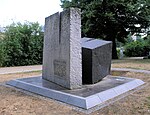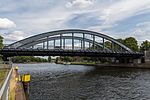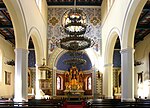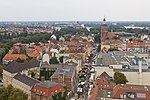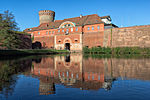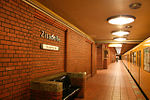Spree (river)

The Spree (German: [ˈʃpʁeː] (listen); Sorbian languages: Sprjewja, Czech: Spréva) is, with a length of approximately 400 kilometres (250 mi), the main tributary of the River Havel. The Spree is much longer than the Havel, which it flows into at Berlin-Spandau; the Havel then flows into the Elbe at Havelberg. The river rises in the Lusatian Highlands, that are part of the Sudetes, in the Lusatian part of Saxony, where it has three sources: the historical one called Spreeborn in the village of Spreedorf, the water-richest one in Neugersdorf, and the highest elevated one in Eibau. The Spree then flows northwards through Upper and Lower Lusatia, where it crosses the border between Saxony and Brandenburg. After passing through Cottbus, it forms the Spree Forest, a large inland delta and biosphere reserve. It then flows through Lake Schwielochsee before entering Berlin, as Müggelspree (listen ). The Spree is the main river of Berlin, Brandenburg, Lusatia, and the settlement area of the Sorbs, who call the River Sprjewja. For a very short distance close to its sources, the Spree constitutes, as Spréva, the border between Germany (Saxony), and the Czech Republic (Bohemia). The Spree's longest tributaries are Dahme (confluence in Berlin-Köpenick) and Schwarzer Schöps (confluence in Sprey), other well-known tributaries (since they are Berlin rivers) are Panke and Wuhle.
Excerpt from the Wikipedia article Spree (river) (License: CC BY-SA 3.0, Authors, Images).Spree (river)
Obermeierweg, Berlin Spandau
Geographical coordinates (GPS) Address Nearby Places Show on map
Geographical coordinates (GPS)
| Latitude | Longitude |
|---|---|
| N 52.536111111111 ° | E 13.208611111111 ° |
Address
Obermeierweg 18
13597 Berlin, Spandau
Germany
Open on Google Maps
